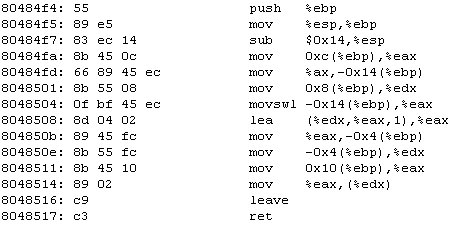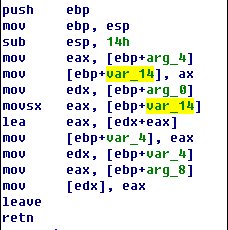move 명령어
http://faydoc.tripod.com/cpu/movsd.htm 에 본문이 있슴.
| Code | Mnemonic | Description |
| A4 | MOVS m8, m8 | Move byte at address DS:(E)SI to address ES:(E)DI |
| A5 | MOVS m16, m16 | Move word at address DS:(E)SI to address ES:(E)DI |
| A5 | MOVS m32, m32 | Move doubleword at address DS:(E)SI to address ES:(E)DI |
| A4 | MOVSB | Move byte at address DS:(E)SI to address ES:(E)DI |
| A5 | MOVSW | Move word at address DS:(E)SI to address ES:(E)DI |
| A5 | MOVSD | Move doubleword at address DS:(E)SI to address ES:(E)DI |
Moves the byte, word, or doubleword specified with the second operand (source operand) to the location specified with the first operand (destination operand). Both the source and destination operands are located in memory. The address of the source operand is read from the DS:ESI or the DS:SI registers (depending on the address-size attribute of the instruction, 32 or 16, respectively). The address of the destination operand is read from the ES:EDI or the ES:DI registers (again depending on the address-size attribute of the instruction). The DS segment may be over-ridden with a segment override prefix, but the ES segment cannot be overridden.
대충 메모리에 있는 데이터를 바이트,워드, 더블 워드 만큼 ESI(src address)에서 EDI(dst address)로 옮긴단 얘기. 계속 설명을 보면..
After the move operation, the (E)SI and (E)DI registers are incremented or decremented automatically according to the setting of the DF flag in the EFLAGS register. (If the DF flag is 0, the (E)SI and (E)DI register are incremented; if the DF flag is 1, the (E)SI and (E)DI registers are decremented.) The registers are incremented or decremented by 1 for byte operations, by 2 for word operations, or by 4 for doubleword operations.
Move 연산 이후에 ESI와 EDI 레지스터는 EFLAGS 레지스터의 DF 플래그에 따라서 값이 증가하거나 감소되거나 한다. DF 가 0 이면 증가, 1이면 감소, 사이즈에 따라서 연산되는 크기도 달라지고.. 마지막엔 이렇게 나와있다.
The MOVS, MOVSB, MOVSW, and MOVSD instructions can be preceded by the REP prefix
MOVS 류 명령어 앞에는 REP 가 올 수 있단다.
같은 사이트에서 REP를 찾아보면..
| Code | Mnemonic | Description |
| F3 6C | REP INS r/m8, DX | Input (E)CX bytes from port DX into ES:[(E)DI] |
| F3 6D | REP INS r/m16, DX | Input (E)CX words from port DX into ES:[(E)DI] |
| F3 6D | REP INS r/m32, DX | Input (E)CX doublewords from port DX into ES:[(E)DI] |
| F3 A4 | REP MOVS m8, m8 | Move (E)CX bytes from DS:[(E)SI] to ES:[(E)DI] |
| F3 A5 | REP MOVS m16, m16 | Move (E)CX words from DS:[(E)SI] to ES:[(E)DI] |
| F3 A5 | REP MOVS m32, m32 | Move (E)CX doublewords from DS:[(E)SI] to ES:[(E)DI] |
| F3 6E | REP OUTS DX, r/m8 | Output (E)CX bytes from DS:[(E)SI] to port DX |
| F3 6F | REP OUTS DX, r/m16 | Output (E)CX words from DS:[(E)SI] to port DX |
| F3 6F | REP OUTS DX, r/m32 | Output (E)CX doublewords from DS:[(E)SI] to port DX |
| F3 AC | REP LODS AL | Load (E)CX bytes from DS:[(E)SI] to AL |
| F3 AD | REP LODS AX | Load (E)CX words from DS:[(E)SI] to AX |
| F3 AD | REP LODS EAX | Load (E)CX doublewords from DS:[(E)SI] to EAX |
| F3 AA | REP STOS m8 | Fill (E)CX bytes at ES:[(E)DI] with AL |
| F3 AB | REP STOS m16 | Fill (E)CX words at ES:[(E)DI] with AX |
| F3 AB | REP STOS m32 | Fill (E)CX doublewords at ES:[(E)DI] with EAX |
| F3 A6 | REPE CMPS m8, m8 | Find nonmatching bytes in ES:[(E)DI] and DS:[(E)SI] |
| F3 A7 | REPE CMPS m16, m16 | Find nonmatching words in ES:[(E)DI] and DS:[(E)SI] |
| F3 A7 | REPE CMPS m32, m32 | Find nonmatching doublewords in ES:[(E)DI] and DS:[(E)SI] |
| F3 AE | REPE SCAS m8 | Find non-AL byte starting at ES:[(E)DI] |
| F3 AF | REPE SCAS m16 | Find non-AX word starting at ES:[(E)DI] |
| F3 AF | REPE SCAS m32 | Find non-EAX doubleword starting at ES:[(E)DI] |
| F2 A6 | REPNE CMPS m8, m8 | Find matching bytes in ES:[(E)DI] and DS:[(E)SI] |
| F2 A7 | REPNE CMPS m16, m16 | Find matching words in ES:[(E)DI] and DS:[(E)SI] |
| F2 A7 | REPNE CMPS m32, m32 | Find matching doublewords in ES:[(E)DI] and DS:[(E)SI] |
| F2 AE | REPNE SCAS m8 | Find AL, starting at ES:[(E)DI] |
| F2 AF | REPNE SCAS m16 | Find AX, starting at ES:[(E)DI] |
| F2 AF | REPNE SCAS m32 | Find EAX, starting at ES:[(E)DI] |
Repeats a string instruction the number of times specified in the count register ((E)CX) or until the indicated condition of the ZF flag is no longer met. The REP (repeat), REPE (repeat while equal), REPNE (repeat while not equal), REPZ (repeat while zero), and REPNZ (repeat while not zero) mnemonics are prefixes that can be added to one of the string instructions. The REP prefix can be added to the INS, OUTS, MOVS, LODS, and STOS instructions, and the REPE, REPNE, REPZ, and REPNZ prefixes can be added to the CMPS and SCAS instructions. (The REPZ and REPNZ prefixes are synonymous forms of the REPE and REPNE prefixes, respectively.) The behavior of the REP prefix is undefined when used with non-string instructions
ECX 또는 ZF 플래그 조건이 충족되는 만큼 문자열 명령을 반복한다.
따라서 REP MOVSD 일때 ECX가 10 이면, ESI 레지스터의 값을 EDI로 10 번 옮기게 된다.
매번 까먹고 구글링에 지쳐서.. 적어놓으면 좀 나을려나.
'Code > assembly' 카테고리의 다른 글
| 기본 색인 주소 지정 모드 (4) | 2009.08.09 |
|---|

